
A window is an opening in a wall, door, roof, or vehicle that allows the exchange of light and may also allow the passage of sound and sometimes air. Modern windows are usually glazed or covered in some other transparent or translucent material, a sash set in a frame in the opening; the sash and frame are also referred to as a window. Many glazed windows may be opened, to allow ventilation, or closed, to exclude inclement weather. Windows may have a latch or similar mechanism to lock the window shut or to hold it open by various amounts.
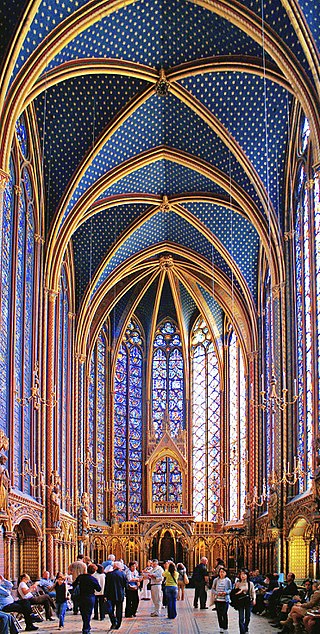
The Sainte-Chapelle is a royal chapel in the Gothic style, within the medieval Palais de la Cité, the residence of the Kings of France until the 14th century, on the Île de la Cité in the River Seine in Paris, France.

Stained glass is coloured glass as a material or works created from it. Throughout its thousand-year history, the term has been applied almost exclusively to the windows of churches and other significant religious buildings. Although traditionally made in flat panels and used as windows, the creations of modern stained glass artists also include three-dimensional structures and sculpture. Modern vernacular usage has often extended the term "stained glass" to include domestic lead light and objets d'art created from foil glasswork exemplified in the famous lamps of Louis Comfort Tiffany.
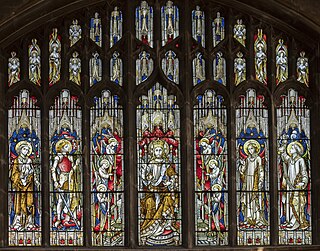
Hardman & Co., otherwise John Hardman Trading Co., Ltd., founded 1838, began manufacturing stained glass in 1844 and became one of the world's leading manufacturers of stained glass and ecclesiastical fittings. The business closed in 2008.

Leadlights, leaded lights or leaded windows are decorative windows made of small sections of glass supported in lead cames. The technique of creating windows using glass and lead came to be known as came glasswork. The term 'leadlight' could be used to describe any window in which the glass is supported by lead, but traditionally, a distinction is made between stained glass windows and leadlights; the former is associated with the ornate coloured-glass windows of churches and similar buildings, while the latter is associated with the windows of vernacular architecture and defined by its simplicity.

Drayton St. Leonard is a village and civil parish on the River Thame in Oxfordshire, about 8 miles (13 km) southeast of Oxford.

Villa Torlonia is a villa and surrounding gardens in Rome, Italy, formerly belonging to the Torlonia family. It is entered from the via Nomentana.

Saint Chrysostom's Church is the parish church in Victoria Park, Manchester, England. The church is of the Anglo-Catholic tradition, and also has a strong tradition of being inclusive and welcoming.

St John the Baptist Church is a Grade I listed parish church in Cardiff, Wales. Other than Cardiff Castle, it is the only medieval building in the city centre.

Cliffe Castle Museum, Keighley, West Yorkshire, England, is a local heritage museum which opened in the grand, Victorian, neo-Gothic Cliffe Castle in 1959. Originating as Cliffe Hall in 1828, the museum is the successor to Keighley Museum which opened in Eastwood House, Keighley, in c. 1892. There is a series of galleries dedicated to various aspects of local heritage, and to displaying the house itself, which is a Grade II listed building. Entrance to the museum is free of charge.

The First Congregational Church is a historic church in Orwell, Vermont. The current meeting house was built in 1843, and is one of state's best examples of Greek Revival ecclesiastical architecture. It was listed on the National Register of Historic Places in 2001.
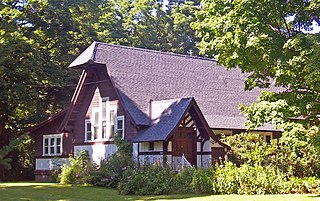
The former Trinity Episcopal Church is located on NY 23B in Claverack, New York, United States. It is a Shingle Style church building from the early 20th century.

The Villa Majorelle is a house located at 1 rue Louis-Majorielle in the city of Nancy, France, which was the home and studio of the furniture designer Louis Majorelle. It was designed and built by the architect Henri Sauvage in 1901-1902. The villa is one of the first and most influential examples of the Art Nouveau architectural style in France. It served as a showcase for Majorelle's furniture and the work of other noted decorative artists of the period, including ceramist Alexandre Bigot and stained glass artist Jacques Gruber. It is now owned by the city of Nancy, and is open to the public certain days for tours by reservation.

The Church of St Stephen and St Thomas is a Church of England parish church in Shepherd's Bush, London. It was built circa 1849–50, designed by architect Anthony Salvin in the Gothic Revival style and is now Grade II listed. The church is located on the South side of Uxbridge Road on the corner of Coverdale Road, to the west of Shepherd's Bush tube station.
St Paul's Church, on St Paul's Road, Clifton, is an Anglican parish church and was formerly the University of Bristol Church, in the City Deanery of the Diocese of Bristol. The church is one of two in the Benefice of St Paul's and Cotham, David Stephenson, inducted as vicar of the Benefice in 2018, is the current incumbent.

St Mihangel's Church in the village of Llanfihangel yn Nhowyn is a former parish church now used as the chapel for RAF Valley in Anglesey, north Wales. The date of the first church on the site is uncertain, but in 1862 the then-existing church was rebuilt. St Mihangel's became the chapel for the nearby Royal Air Force base in 1998, after the Church in Wales had ceased using it for services. It was then extended by dismantling and reassembling another Anglesey church, St Enghenedl's, at the west end of the building.
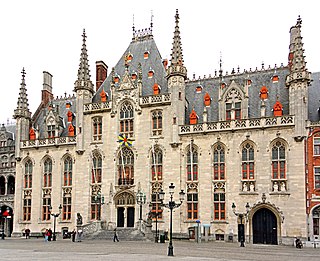
The Provinciaal Hof is a neo-Gothic building on the Markt in Bruges, Belgium. It is the former meeting place for the Provincial Government of West Flanders.
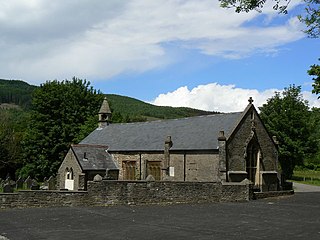
St. Cadoc's Church is a Church in Wales church in Glynneath, Wales. It is located in the grounds of the now derelict Aberpergwm House for which it was an estate church.

John Halle's Hall is a 15th-century late medieval building, a hall house, in Salisbury, England, with later 16th-, 19th- and 20th-century additions. The Hall is a Grade I listed building, the top category, 'of highest significance'. The medieval part of the building is now the foyer of a cinema, with a Victorian mock-Tudor street façade added in 1880–1881, together with the main cinema screening room built in 1931 behind the foyer. The noted architectural historian Sir Nikolaus Pevsner described this conglomeration as ' ... a great curiosity, a cinema with a grossly overdone timber-framed Tudor façade ..., and behind this façade the substantial and memorable remains of the House of John Hall'.

The Cathedral of the Nativity of Our Lord is a Georgian Orthodox church located on the border of Upper Clapton and Stamford Hill, London. Since its opening in 1892 as the Agapemonite Church of the Ark of the Covenant it has served as the sole London outpost of three very different Christian denominations. During the second half of the twentieth century it was the Church of the Good Shepherd and belonged to the Ancient Catholic Church, a now defunct denomination. In 2011 it became a Georgian Orthodox Cathedral and gained its current name. It is a Grade II* listed building, in part because of its exceptional Arts and Crafts stained glass windows but also as the former headquarters of a late-Victorian Christian cult.





















